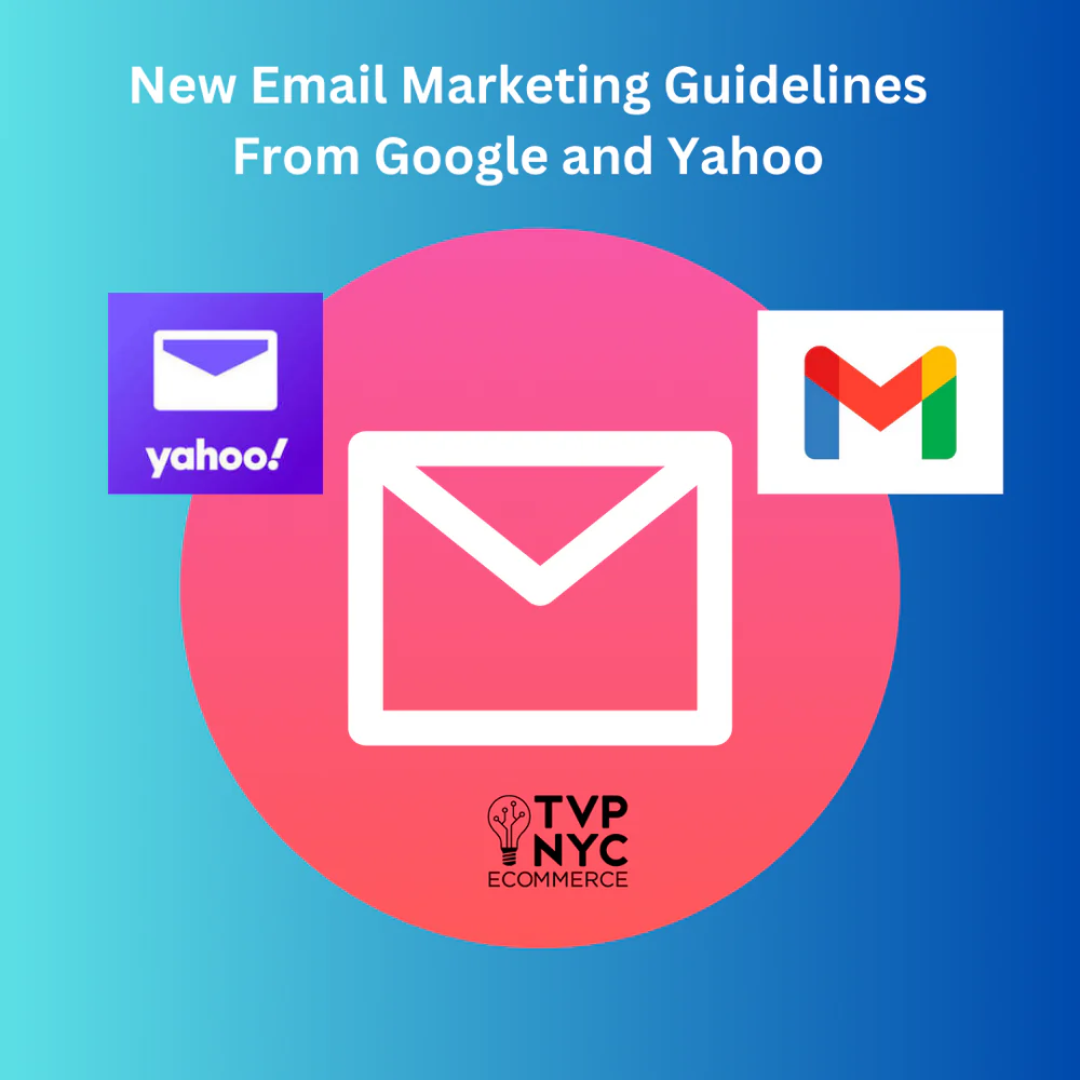Google and Yahoo have announced changes that require you to make changes before February 1, 2024 if you’d like to send emails from a branded email address.
This blog explores the key components of the new requirements and provides actionable insights to help you navigate the changes.
“If you take no action by the above date, we will rewrite your sender email to store@shopifyemail.com to meet the minimum requirements outlined by Google and Yahoo, so that you may continue sending emails to your customers without interruption.”
This means that you’ll have to get this updated before February or you may notice significant disruptions to your eCommerce store and eCommerce email marketing results.
New Email Rules from Google & Yahoo - Why?
Google and Yahoo’s lofty goal is to enforce better email standards that will provide a safer and less spammy email experience for users.
Adding a DMARC record to your domain is a proactive measure to secure your email communication, protect your brand, and improve deliverability. By carefully configuring your DMARC policy and monitoring the associated reports, you can stay one step ahead of potential email-based threats. Remember, the implementation of DMARC is an ongoing process that requires periodic reviews and adjustments to adapt to changes in your email infrastructure and potential security threats.
It’s all good, but what should you do about it?
Your Next Steps
To meet the new sender requirements, Shopify Merchants will have to:
- Keep a complaint rate of < 0.3% and ideally below 0.1% to prevent mail from getting filtered into customers’ spam folders. Complaint rates are calculated as the number of emails customers are marking as spam / the number of emails that are getting inboxed. Check your Gmail complaint rate by setting up Google Postmaster Tools
- Authenticate Shopify to send emails for your domain. Check if you’ve authenticated
- Have a DMARC policy for your domain, with a minimum p=none policy setting.
If you received the DMARC notification to your eCommerce store from Shopify, please take action.
What is DMARC?
DMARC (Domain-based Message Authentication, Reporting, and Conformance) is a crucial tool to protect your domain from phishing and email spoofing attacks. Implementing DMARC can significantly enhance your email deliverability and safeguard your brand reputation. In this blog post, we'll guide you through the process of adding a DMARC record to your domain.
Understanding DMARC
DMARC is an email authentication protocol that builds on two existing mechanisms: SPF (Sender Policy Framework) and DKIM (DomainKeys Identified Mail). It allows domain owners to specify how email receivers should handle messages that fail authentication, providing a powerful defense against email-based threats.
How to Create a DMARC Record
You may follow the instructions sent by your platform provider or ESP, (or reach out to us and we can work with you to get it done) but at the very least, your DMARC should include:
- v (version): Specifies the DMARC protocol version.
- p (policy): Defines the policy for handling messages that fail authentication.
- rua (reporting URI for aggregate data): Indicates the email address to receive aggregate reports.
- ruf (reporting URI for forensic data): Specifies the email address for receiving forensic reports.
Detailed Instruction from Google:
Have the text file or line that represents your policy record ready.
- Sign in to the management console for your domain host.
- Locate the page where you update DNS records.
- Add a DNS TXT record, or modify an existing record, by entering your record in the TXT record for _dmarc:
-
TXT record name: In the first field, under the DNS Host name, enter: _dmarc.yourdomain.com
Important: Some domain hosts automatically add the domain name after _dmarc. After you add the TXT record, you can verify the DMARC TXT record name to make sure it's formatted correctly. -
TXT record value: In the second field, enter the text for your DMARC record, for example: v=DMARC1; p=none; rua=mailto:dmarc-reports@yourdomain.com
The field names might be different for your provider. DNS TXT record field names can vary slightly from provider to provider.
What Else You Can Do to Boost Email Marketing in 2024
Email marketing has certainly withstood the test of time, continually proving its worth as a direct and personalized means of communication. While it may feel a little technical, the new guidelines for 2024 from Google and Yahoo offer businesses an opportunity to revamp their overall email strategies while implementing the required changes.
Here’s what you should look at:
1. Permission-Based Marketing
Ethical and effective email marketing is built on a foundation of permissions. The 2024 guidelines stress the importance of obtaining explicit consent from recipients before sending marketing emails.
Getting this will ensure that you comply with data protection regulations, and it will establish a relationship of trust with the audience. Your focus should be on building a list of engaged subscribers who willingly opt-in to receive communications
2. Personalization and Relevance
Personalization has long been a buzzword in marketing. Beyond simply addressing recipients by their first name, personalization now involves understanding individual preferences and tailoring content accordingly.
Leveraging data insights is crucial to creating hyper-relevant campaigns that resonate with the audience on a personal level. At TVP, we're ALL about data-driven solutions. Talk to us about what data can do for your email marketing campaigns.
3. Data Security and Compliance
In an era where data breaches and privacy concerns make headlines, the guidelines emphasize the need for robust data security measures.
eCommerce companies should prioritize protecting customer information, implementing encryption protocols, and staying on top of evolving data protection regulations. Compliance is a legal requirement, but it also shows you are committed to respecting your audience's privacy.
4. Deliverability Best Practices
Getting your emails into the recipient's inbox is half the battle. Deliverability best practices include:
- Avoiding spam triggers.
- Optimizing email content and structure.
- Maintaining a positive sender reputation.
Your company should continually monitor and adapt its practices to ensure its messages land where you want them to.
5. List Hygiene
A clean and well-maintained email list is the backbone of successful email marketing. List hygiene means cleaning your subscriber lists regularly. Removing inactive subscribers, handling bounce rates, and ensuring accurate and up-to-date information is crucial to maintaining a healthy email list
6. Content Guidelines
Compelling content is the heart of any successful email campaign. You must create content that captures attention and provides value to the audience. From crafting engaging subject lines to producing visually appealing and informative content, making your emails stand out in a crowded inbox is crucial.
7. Automation Best Practices
Automation is a cornerstone of efficient email marketing. The new guidelines offer best practices for implementing automation strategies that save time, enhance personalization, and drive better results.
You can leverage automation for tasks such as sending welcome emails, re-engaging inactive subscribers, and providing personalized content based on user behavior.
8. Monitoring and Analytics
Continuous monitoring and analysis are imperative for refining and optimizing email marketing strategies. eCommerce companies should set up tracking for key metrics using analytics tools.
When you regularly analyze metrics like open rates, click-through rates, and conversion rates, you'll be privy to valuable insights into how your email campaigns are performing, making data-driven decisions a breeze.
Google and Yahoo’s New Guidelines Can Boost Your Business!
As we embrace the new era of email marketing in 2024, sticking to the new guidelines is essential for success. The evolution of email marketing reflects the dynamic nature of digital communication, and eCommerce businesses that adapt to these changes will not only meet but exceed the expectations of their audience.
By implementing these key components, you can navigate the intricacies of email marketing, cultivate more robust connections with your audience, and drive meaningful campaign results in the years to come.




